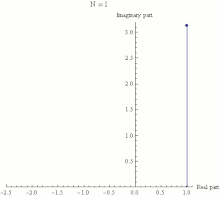Euler's identity

| Part of a series of articles on the |
| mathematical constant e |
|---|
 |
| Properties |
| Applications |
| Defining e |
| People |
| Related topics |
In analytical mathematics, Euler's identity (also known as Euler's equation), named for the Swiss mathematician Leonhard Euler, is the equality
where
- e is Euler's number, the base of natural logarithms,
- i is the imaginary unit, which satisfies i2 = −1, and
- π is pi, the ratio of the circumference of a circle to its diameter.
Explanation

The identity is a special case of Euler's formula from complex analysis, which states that for any real number x:
- where the values of the trigonometric functions sine and cosine are given in radians.
In particular, when x = π, or one half-turn (180°) around a circle:
Since
and
it follows that
which yields Euler's identity:
The physical explanation of Euler's identity is that it can be viewed as the group-theoretical definition of the number π. The following discussion is at the physical level, but can be made mathematically strict. The "group" is the group of rotations of a plane around 0. In fact, one can write:
with δ being some small angle.
The last equation can be seen as the action of consecutive small shifts along a circle, caused by the application of infinitesimal rotations starting at 1 and continuing through the total length of the arc, connecting points 1 and −1 in the complex plane. Each small shift may then be written as:
and the total number of shifts is π/δ. In order to get from 1 to −1, the total transformation would be:
Taking the limit when δ → 0, denoting iδ = 1/n and the equation , we arrive at Euler's identity.
π is defined as the total angle which connects 1 to −1 along the arc. Therefore, the relation between π and e arises because a circle can be defined through the action of the group of shifts which preserve the distance between two points on the circle.
This simple argument is the key to understanding other relations involving π and e.
Generalizations
Euler's identity is also a special case of the more general identity that the nth roots of unity, for n > 1, add up to 0:
Euler's identity is the case where n = 2.
In another field of mathematics, by using quaternion exponentiation, one can show that a similar identity also applies to quaternions. Let {i, j, k} be the basis elements, then,
In general, given real a1, a2, and a3 such that , then,
For octonions, with real an such that and the octonion basis elements {i1, i2,..., i7}, then,
Attribution
While Euler wrote about his formula that relates e with cosine and sine terms, in the field of complex numbers, there is no known record of Euler's actually stating or deriving the simplified identity equation itself. Furthermore, Euler's formula was probably known before the life of Euler.[1]
Mathematical beauty
Euler's identity is considered by many to be remarkable for its mathematical beauty. These three basic arithmetic operations occur exactly once each: addition, multiplication, and exponentiation. The identity also links five fundamental mathematical constants:
- The number 0, the additive identity.
- The number 1, the multiplicative identity.
- The number π, which is ubiquitous in trigonometry, the geometry of Euclidean space, and analytical mathematics (π = 3.14159265...)
- The number e, the base of natural logarithms, which occurs widely in mathematical and scientific analysis (e = 2.718281828...). Both π and e are transcendental numbers.
- The number i, the imaginary unit of the complex numbers, a field of numbers that contains the roots of all polynomials (that are not constants), and whose study leads to deeper insights into many areas of algebra and calculus, such as integration in calculus.
Furthermore, in algebra and other areas of mathematics, equations are commonly written with zero on one side of the equals sign.
A poll of readers conducted by The Mathematical Intelligencer named Euler's identity as the "most beautiful theorem in mathematics".[2] Another poll of readers that was conducted by Physics World in 2004 chose Euler's identity tied with Maxwell's equations (of electromagnetism) as the "greatest equation ever".[3]
An entire 400-page mathematics book, Dr. Euler's Fabulous Formula (published in 2006), written by Paul Nahin (a professor emeritus at the University of New Hampshire), is devoted to Euler's identity, especially its applications in Fourier analysis. This monograph states that Euler's identity sets "the gold standard for mathematical beauty".[4]
Constance Reid claimed that Euler's identity was "the most famous formula in all mathematics".[5]
The mathematician Carl Friedrich Gauss was reported to have commented that if this formula was not immediately apparent to a student upon being told it, that student would never be a first-class mathematician.[6]
After proving Euler's identity during a lecture, Benjamin Peirce, a noted American 19th-century philosopher, mathematician, and professor at Harvard University, stated that "it is absolutely paradoxical; we cannot understand it, and we don't know what it means, but we have proved it, and therefore we know it must be the truth."[7]
Stanford University mathematics professor Keith Devlin said, "Like a Shakespearean sonnet that captures the very essence of love, or a painting that brings out the beauty of the human form that is far more than just skin deep, Euler's equation reaches down into the very depths of existence."[8]
In popular culture
Euler's identity is referenced in at least two episodes of The Simpsons: Treehouse of Horror VI (1995);[9] and MoneyBart (2010).[10]
See also
Notes
- ^ Sandifer.
- ^ Nahin, 2006, p.2–3 (poll published in the summer 1990 issue of the magazine).
- ^ Crease, 2004.
- ^ Cited in Crease, 2007.
- ^ Reid, p. 155.
- ^ Derbyshire p.210.
- ^ Maor p. 160 and Kasner & Newman p.103–104.
- ^ Nahin, 2006, p.1.
- ^ Cohen, David X (2005), "Commentary for "Treehouse of Horror VI", The Simpsons: The Complete Seventh Season, 20th Century Fox
- ^ Singh, Simon (22 September 2013). "The Simpsons' secret formula: it's written by maths geeks". The Guardian. Retrieved 22 September 2013.
{{cite news}}: Check date values in:|date=(help)
References
- Crease, Robert P., "The greatest equations ever", PhysicsWeb, October 2004 (registration required).
- Crease, Robert P. "Equations as icons," PhysicsWeb, March 2007 (registration required).
- Derbyshire, J. Prime Obsession: Bernhard Riemann and the Greatest Unsolved Problem in Mathematics (New York: Penguin, 2004).
- Kasner, E., and Newman, J., Mathematics and the Imagination (Simon & Schuster, 1940).
- Maor, Eli, e: The Story of a number (Princeton University Press, 1998). ISBN 0-691-05854-7
- Nahin, Paul J., Dr. Euler's Fabulous Formula: Cures Many Mathematical Ills (Princeton University Press, 2006). ISBN 978-0-691-11822-2
- Reid, Constance, From Zero to Infinity (Mathematical Association of America, various editions).
- Sandifer, Ed, "Euler's Greatest Hits", MAA Online, February 2007.

















